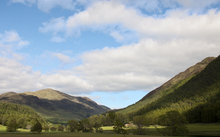Glen Lyon

Glen Lyon (
This glen was also known as An Crom Ghleann ("The Bent Glen"). The land given over to the MacGregors was An Tòiseachd. It forms part of the Loch Rannoch and Glen Lyon National Scenic Area, one of forty such areas in Scotland, which are defined so as to identify areas of exceptional scenery and to ensure its protection from inappropriate development by restricting certain forms of development.[1] Sir Walter Scott described Glen Lyon as the "longest, loneliest and loveliest glen in Scotland".[2] Apart from a few scattered farms and cottages throughout the glen, the only real settlements are at Fortingall and Bridge of Balgie.
The glen contains several small hamlets and has a primary school where Gaelic is taught weekly.
History

Quite densely inhabited from prehistoric times (as many archaeological sites attest), although its present population is of modest size, the glen has been home to many
At the end of the 11th century the de Leons (later shortened to "Lyon") had come north with
Glen Lyon, also written Glenlyon, has been the home of (among others)
Their history is described in Alexander Stewart's A Highland Parish (1928), and Duncan Campbell's The Lairds of Glenlyon (1886).
Notable people
- Isobel Forrester an ecumenist was born at Glenlyon manse in 1895.[10]
- Fr. James MacGregor (medieval Scottish Gaelic literature. His Chronicle, covering local events in a mixture of Middle Scots and Ecclesiastical Latin, is also still extant, and is an important historical source for the central Highlands.
- Scottish descent, explored the legacy of his Glen Lyon ancestors in his memoirs.
Gallery
-
River Lyon
-
Cattle in Glen Lyon
References
- ^ "National Scenic Areas". Scottish Natural Heritage. Retrieved 17 January 2018.
- ISBN 978-1-84486-520-8. Retrieved 24 July 2018.
- ISBN 9780773522916. Retrieved 14 December 2017.
- ^ Herald, Ross (1911). "Lyon, Earl of Strathmore and Kinghorne". Scotts Peerage: 1.
- ^ Anderson, W (1862). "The Story of the Family Lyon". The Scottish Nation. 3.
- ^ "The Story of the Family Lyon". Some Old World Lyons – via The American Lyon Association.
- ^ Thomson, Ingrid, Glamis Castle Archivist
- ^ British Museum Collection
- ^ Carnbane Castle and a banquet for a bard
- , retrieved 5 June 2023


